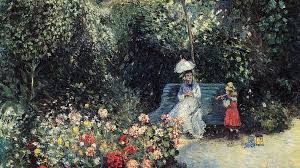T.J. Clark at the LRB:
 Nonetheless, Cézanne came to Pissarro to unlearn his first style, and, seemingly, to change his mind about Courbet, Manet and Delacroix; or at least about what might be made from them, from their attitudes (their subjects, their stances) and their materials. Provocation in art would give way to patience, to exposure to optical events. The word ‘humble’ which Cézanne chose years later to characterise Pissarro – ‘humble and colossal’, he called him, and perhaps even ‘justified in his anarchist theories’ – sums up a number of things. The way forward for French painting, Cézanne seems to have decided in 1873, was to be found in the style that Monet had built, and to which Pissarro had given his distinctive stamp, in the very years when Cézanne had built his massive contrary to Monet’s lightness and impersonality. (‘Monet, around 1869, he struck the great blow’ was Cézanne’s verdict in retrospect. ‘Monet and Pissarro, the two great masters, the only two.’) The Courbet, Manet and Delacroix in oneself, in other words – and no doubt the three remained heroes – would have to be painted out. Sometime in the winter of 1872-73 (I shall return to this later) Cézanne borrowed a landscape Pissarro had done two years before, in the first heyday of Impressionism, and sat down to copy it stroke by stroke.
Nonetheless, Cézanne came to Pissarro to unlearn his first style, and, seemingly, to change his mind about Courbet, Manet and Delacroix; or at least about what might be made from them, from their attitudes (their subjects, their stances) and their materials. Provocation in art would give way to patience, to exposure to optical events. The word ‘humble’ which Cézanne chose years later to characterise Pissarro – ‘humble and colossal’, he called him, and perhaps even ‘justified in his anarchist theories’ – sums up a number of things. The way forward for French painting, Cézanne seems to have decided in 1873, was to be found in the style that Monet had built, and to which Pissarro had given his distinctive stamp, in the very years when Cézanne had built his massive contrary to Monet’s lightness and impersonality. (‘Monet, around 1869, he struck the great blow’ was Cézanne’s verdict in retrospect. ‘Monet and Pissarro, the two great masters, the only two.’) The Courbet, Manet and Delacroix in oneself, in other words – and no doubt the three remained heroes – would have to be painted out. Sometime in the winter of 1872-73 (I shall return to this later) Cézanne borrowed a landscape Pissarro had done two years before, in the first heyday of Impressionism, and sat down to copy it stroke by stroke.
more here.
